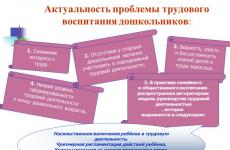Complex tank deployments. DIY cardboard tank step by step. Ideas for tanks that shoot
From paper.
On the eve of the holidays of February 23 and May 9, I want to give you a selection of paper tanks. And most importantly, how to make them yourself.
Also in the article you will find diagrams for origami and templates for cutting and gluing models. There will be, like modern models of combat vehicles, and those from the times of the First and Second World Wars.
In general, not all of the proposed ideas are simple. However, there are also things that a child attending kindergarten can do.
Add the article to your bookmarks so as not to lose it, because at school and kindergarten they will definitely ask you to make a craft, so let the ideas be at your fingertips.
Let's start with simple ideas. Schoolchildren can already create them by repeating the steps in the master classes. however, young children will need adult help.
Master class No. 1.

For this craft you need to take 3 matchboxes, 2 sheets of double-sided green paper, a green bottle cap and a lollipop stick, strips of black and red self-adhesive sheets.
Take a sheet of paper. We put two cardboard boxes on one and measure the length and width. We remove the boxes, and leave 1 cm allowances from the marked lines. Then cut out the wrapper.
Ask your parents to put a lollipop stick in the lid.


We paste the resulting blanks of wrappers over the matchboxes. Two will go to the longest, and one to the shortest.

We cut out the tracks, slightly wider than the narrow sides of the matchboxes.
Cut out 6 circles from black paper and paste them onto the tracks.
From a red leaf we will make a star to decorate the craft.
Master class No. 2.
An option when you need to take one matchbox and a slightly larger box as a basis.
Also, as in the previous version, you need to wrap the boxes with green paper. Glue them on top of each other.
For caterpillars, take stiffeners from a cardboard box or dark-colored corrugated paper.
For the muzzle, take a chupik or lollipop stick. We wrap it with a green strip and insert it into the cabin. It is fashionable to make a hole for the muzzle, or you can fix it with a heat gun.

Master class No. 3.
Another idea using three matchboxes, buttons and paper.

First we glue one box. Then two. It turns out two blanks: one is smaller than the other.


Place the smaller piece on top of the larger one and secure it with glue.

Glue buttons of the same size along the edges.

Take a soda cap and use a hot awl to make a hole in it, into which we insert a lollipop stick.

Along the edges we imitate caterpillars with black paper.

Master class No. 4.
A very simple tank idea. The main thing is to carefully repeat all the steps in the photo instructions.

From double-sided paper, cut out two strips 20 cm long and 2 cm wide.

Glue them into rings.

We measure a piece of paper measuring 12*7 cm. We mark 0.5 cm from both edges. Then 2.5 cm from this line.



Now those lines 0.5 cm wide need to be bent away from you using a ruler. We bend all the lines one by one, changing the side of the bend.

We make a second similar part of a smaller size 8*5 cm

Let's make a barrel.

You need to take a segment with dimensions of 4-8 cm. And mark lines in length every centimeter. 


We bend it and glue it to the cabin - the smaller part.

We take a large part and glue the cabin onto it, tucking the allowances inward.

We take our “rings” and flatten them a little with our hands to get an oval. Glue the caterpillars in place.

All that remains is to decorate the craft.
Master class No. 5.
A simple craft for little ones.

Cut out similar parts and invite the child to stick the blanks on the right places.

Master class No. 6.
An option for those who like to tinker. Everything here is more realistic than in the previous version.

Place 4 empty matchboxes together. This will be the base of the tank.

Let's take another box for the cabin. We cover them with colored paper.

We pierce the cabin with an awl or a knitting needle and insert the barrel.

We make a hole in the middle with an awl. We need it to make a rotating cabin.

For the muzzle, you can take any thin stick. For example, from a lollipop or a kebab skewer. You can use scissors to enlarge the hole if the tube does not fit.

Take the lid and use a hot awl to make a hole in it.
Now we need a rod. It needs to be heated over a fire and cooled on metal. This is necessary so that the plug is baked on the end. It will hold all our parts together. This work should be done by adults! The child may get burned!

We pass the rod through the cabin and the cover.

We pass it through the base with tracks.

Cut out five strips with a width of 1.5 cm from dark-colored paper. From 4 we make an “accordion” and glue them onto the tracks. From the rest we cut out circles and glue them onto the end part of the base.
Master class No. 7.
Option made of paper and sleeves. A very simple and quick craft. However, it looks very decent!

The upper edges of the bushings are painted dark.

We fix them together with masking tape.

We take thick paper and decorate the place with adhesive tape.

We measure out two strips of silver corrugated cardboard, 2 cm wide and a length corresponding to the width of the tracks. Glue the cardboard to the desired places on the sides.

From thick paper we roll up a box without side walls.

We decorate everything with the same leaf color.

We collect the details into one craft.

We will make a barrel from a cocktail tube. Let's wrap it around.

We make a hole in the cabin and check that the tube fits into it and does not fall out.

We insert the barrel and decorate the tank.

Master class No. 8.
Another simple and easy idea for children.

Here is a diagram with dimensions. Transfer it to A4 sheet and cut out all the details. Bend all the pieces along the fold line.

You need two of these caterpillar parts.

Glue black circles onto the front part. The folded allowances are used for gluing with other parts of the craft.

We cover the ends of the caterpillars with black stripes. This is what happens.

We take the base rectangle and glue it, connecting the finished parts of the tank.

This is what the workpiece looks like from the front side.

We cut out the cabin and folded it along the indicated lines, alternating the folding side. 
We make a hole in it and decorate the back of the cabin with a star.
Glue it onto the base.

We roll up the barrel and insert it into the hole.

The craft is ready. You can make an imitation of the Eternal Flame or add orders to it. You will find a layout of the order at the end of this article.
Paper tank using origami technique - step-by-step instructions for beginners
Now a section for those who love origami techniques. You will see 5 detailed step-by-step diagrams.
Let's start with this option called "Abrams".

Take a spread of the notebook. In total this is A4 size. Fold it along the fold, then in half and cut it. We bend one of the parts diagonally to the middle. Along the marked lines we bend the part so that the edge forms a triangle, as in the photo.




This results in a model.

Another option for a hand-folded tank.

















Another diagram with detailed actions and indicated lines.

A variant of the simplest origami product.

The scheme is for those who are just beginning to master the basics of this technique. The craft is made from one sheet.

Mastering this technique produces such beauty.


These tank options can also be used for holiday themed gifts and crafts.
Cardboard master class
Paper cardboard allows you to make durable crafts. They will not bend as quickly as the previous ones. And you can even play with them.
There are two master classes before you.
First option.

You need to take corrugated cardboard, it is sold in any office supply store. Or remove the top layer from the cardboard box, exposing the stiffening ribs.
We make round rolls from thin strips.

We connect them to a rectangular base.

We twist the cabin on top.

We make a barrel and decorate the craft with flags.

This beauty is made from cardboard.



Option 2.


Blue ribbons will be used for roller wheels, the cabin and decoration. Green ones are for the caterpillars themselves.

We roll the tracks from 4 spherical rolls. We take two strips of the same size. The next two need to be taken three centimeters less.

We tie them with ribbon to hold the rolls together.

We make the base for the cabin and tracks.

To prevent them from unraveling, we glue them with PVA glue.

Let's do the remaining details.

Entire compositions are created and sent to exhibitions.

I also suggest watching a video that shows you step by step how to create a tank.
All models can be modified to your liking.
Ideas for tanks that shoot
And now before you are three ideas for cars that were recorded at the shooting stage. Of course, these are comic models of children's creativity. A pom-pom made of red threads, tinsel or toothpicks can “fly” from the barrel.

As we can see, circles and hearts of red paper were glued onto the toothpicks, which imitate the speed and speed of the shot.

Such a fun idea with hearts.

Pay attention to the crafts themselves. They can inspire you to create a wonderful composition.
Tanks that can be printed, cut, glued
Now you will have many templates to cut out. They need to be printed on thick paper or photo paper. Then cut out all the parts along the contours and glue them together.

The whole composition: a tank on a pedestal.

The following is a diagram with assembly instructions.

The next sketch is simple and can be assembled quickly.

T-34 paper tank
When assembled it looks like this.

You need to print these diagrams.





Now for a detailed assembly diagram.



Tank T-90
This scheme is suitable for the T-90.



Assembly instructions.



Other famous tanks
Comic idea of a tank with a diagram.



World War II model.

The next model is M-36.

T-40 car.

Schematic machine MK1.

Another option.

There are also modern models.

Izvestny KV-1.

We are making ISU-152.

Model SU-100.


With the proper level of accuracy and care, you can assemble quite realistic cars.
Tank coloring pages
Children can use coloring books and templates for appliqués and postcards. I'll give you a small selection.







Remember, she promised to give a medal with a tank? So here she is.

Have fun with your children, explaining what a great thing our ancestors did, bringing victory to the USSR!
Paper tank ideas
And in conclusion, a small selection of ready-made DIY crafts. Some people create entirely on their own, while others get help from their parents.
For inspiration, take the idea of bushings.

Or the square cabin idea.

Gift option made of corrugated paper.



Tank made of round parts.


A similar model was made above from green cardboard.

Quick craft idea.


Passionate people create life-size crafts from cardboard and even plywood.















What do you think of the selection? I am sure that both older schoolchildren and younger preschoolers will find inspiration here. Also show the ideas to dads, maybe they will also be inspired and help the kids create crafts.
Tweet
Tell VK
Previously, we published several schemes, but today we want to complement this collection with a new model - T-10 tank made of paper.
The prototype of the T-10 tank was created by Soviet engineers back in 1944, but it was called IS-4. Only after the death of I. Stalin, after whom it was named, was it renamed T-10.
The T-10 heavy tank (its weight is as much as 50 tons) had such good combat and tactical characteristics that its modernized prototypes (see “”) were in service with the Soviet Army right up to 1993.
The tank is equipped with a 122 mm cannon, which could shoot accurately at a distance of 5 km. Its engine developed a power of 750 horsepower. The tank could overcome water obstacles up to 5 m deep (it crossed rivers along the bottom).
Making a T-10 tank from paper
In order to make this model paper tank First, print out diagrams (scans) of the parts on a printer, preferably a color one. However, if this is not possible, it doesn’t matter. The tank parts can always be painted.
To print out diagrams of tank parts, you need to choose thick paper, such as photo paper or thin cardboard. Then the tank model will be strong and more durable.
Use sharp scissors to cut out parts. You can also use a utility knife.
Once the pieces are cut out, use an old ballpoint pen and a ruler to make neat folds used to glue the pieces together.
You can use any glue, but a dry glue stick is better. The fact is that it will make the tank model more accurate, since there will be no smudges from it, and the paper will not curl.
Paper diagrams of T-10 tank parts


Instructions for gluing the tank

For dessert, we invite you to look at the domino principle in action, a world record of 125 thousand pieces. Watch until the end. It's worth it.
Paper modeling can be classified as an activity that never ceases to interest a person. Many orphanages for creativity always organize design clubs, because paper models not only provide an opportunity to get a new interesting figurine or toy, but with their help you can improve your knowledge of physics and mathematics.
Tools for work
To learn how to fold basic paper models, you will need simple tools such as scissors, a utility knife, PVA glue and a brush for applying it. Give preference to PVA construction glue - of all varieties, it has the thickest consistency; it does not spoil the paper, making it wet and sticky, like regular glue.
Different models are folded from different types of paper - from tissue paper to thick cardboard. Beginners are advised to start with 200 grams per m2 watercolor paper for large elements and drawing paper with a density of 140-160 grams per m2 when developing small parts.
Craftsmen create individual parts, such as masts, railings, small finishing elements, from polymer clay, plaster, plasticine and self-hardening plastic. If you also complement your work with molded parts, stock up on various stacks and molds - like those used in ceramic floristry.
How to make a paper model
The workflow for creating a paper model takes place in several simple steps. Before starting the process, the master decides what kind of figurine he wants to construct. In fact, almost any product can be made from paper, but paper modeling often involves the following options:
- geometric figures, polyhedra with convex and concave corners;
- scaled copies of famous buildings;
- luxury car models;
- models of military equipment: tanks, armored vehicles, heavy guns;
- vehicles: airplanes, ships and submarines, trains.
Figures of humans, animals, and plants are constructed much less frequently than others. After determining the product category, the main part of the work process begins.
Creating a Layout
Three-dimensional paper models are made from several large and small parts - the diagrams of the elements must first be drawn on paper sheets of the desired color. A person cannot cope here without understanding certain knowledge of geometry and the ability to represent a three-dimensional image.
To make it easier for beginners to learn, many specialized magazines began to publish drawings of ready-made developments for the paper model, by gluing them together to create a figurine.
You also need to cut out the layout according to the rules. For example, a solid line along the contour indicates the location of the cut, and a dotted line indicates the fold. But in each diagram the designations are individual, so before cutting you need to read the explanations for the figure.
Assembly
After the drawings of the paper model are ready, the model is glued together and finishing work is carried out, if necessary.
To make the surface of the product look realistic, craftsmen use different coatings: glossy varnishes, matting sprays, craquelure liquids, stains, etc.
Paper car models
A beginner in the business of paper modeling will enjoy this master class, which contains information on how to construct the famous model of a VAZ 21011 sedan car in just half an hour.
Stock up on thick drawing paper or a coated sheet if the figurine is being created as a gift for a friend.
- On an A4 sheet of paper using a color printer, print out the finished layout of the paper model with your own hands. If you want to enlarge the diagram, make sure that the proportions of length and width are maintained - changing the parameters may interfere with the correct joining of the parts.

- Have a picture of a real car of that brand in front of you to use the picture as a guide when assembling. Bend the development in the required places.

- Shape the blank into the shape of a car to mark the gluing areas for yourself. Only after this can you sequentially lubricate the white valves with glue and glue them to the necessary parts from the inside, fastening the parts of the machine to each other.
Please note that the tread strips need to be glued together to form rings that will be attached to the wheels in order to obtain the most voluminous paper models.
Paper tank models
Designing military equipment from paper is somewhat more difficult than creating civilian vehicles because the guns consist of many small parts that form the body.
To see this, try to create a difficult but very interesting model of the German Panther tank.

- On a thick A4 sheet, print drawings of the tank components using a color printer. It is better to cut out small parts from thin cardboard so as not to bend the narrow curled elements.

- You need to cut out the parts with sharp scissors to make the work easier.

- It is better to glue in blocks - separately connect the parts of the hull, propulsion system and turret, and then fasten the large elements together.

To glue the parts of the tank in the correct order, follow this video tutorial during assembly.
Sometimes the joints are connected with small errors, which is why white paper stripes appear on the model. You can get rid of them using felt-tip pens or pencils of a similar color to the armor.
Paper airplane models
If you already have some skills in building paper figures, you will probably enjoy constructing a paper and cardboard model of the Tu-104 passenger aircraft.

- Print out the airplane drawings on thick paper.

- Glue the elements of the internal frame of the product onto thin cardboard - they are marked with red numbers.

- The parts marked with a cross - frames or frame - are transferred to the cardboard using a compass. In this case, you can calculate the radius of the circle by placing the needle of a compass in the middle of the cross and a pencil on the circle. Patterns of paper frames need to be glued to these cardboard blanks.

- After developing the frame, start creating the fuselage, or body of the aircraft. Please note that, unlike previous products, fuselage sections #1-8 do not have white securing flaps. They are connected to each other with special ribbons, represented on the patterns by the corresponding numbers in blue.

- The frames are glued into the joints between the fuselage sections.

- While the glue in the airplane body is drying, glue the tail parts together.

- The engines of the device are assembled like a fuselage.

- Next, the wings are formed using cardboard and paper.

- Connect the parts of the hull, wings, bow and cockpit together.

- The chassis is assembled in several stages - initially the wheels and their components are formed, after which the chassis is glued to the wings in a specially designated place.

- You can also use the pattern to cut out a wooden chassis - it will be stronger and last longer than paper and cardboard.

To avoid bends and creases on the body and tail, stuff the parts with cotton wool during assembly. Decorate the plane as desired using decoupage sprays and paints.
You can make a simpler model of a paper airplane with your own hands, following this video.
Take it for yourself and tell your friends!
Read also on our website:
show more
With this article you will learn how to make a paper tank with your own hands. This instruction includes 2 options for making such crafts. They vary in complexity and technique. The first master class is quite simple and quite suitable for beginners. The second is labor-intensive and complex. If you don't have any experience with origami, try a simpler one first.
A paper tank sounds quite serious. It seems that making such a craft is very difficult. And this is not at all true! Given some free time and some patience, you can easily create one. Read on and you will learn how to make a paper tank with your own hands. 
Materials and tools:
- plain or colored A4 paper;
- gray pencil;
- thin metal ruler;
- PVA or stationery glue;
- scissors.
How to make a simple tank out of paper
This craft is easy to make and perfect for beginners. To make it, you will need one sheet of A4 colored paper, a small piece of paper in a contrasting color, scissors and a pencil. 
Production time – 20 minutes
Difficulty level – easy.

Step 1: Make the folds
Take a standard A4 sheet of paper. 
Fold it in half lengthwise. 
Fold the top left corner to the bottom edge. Iron the folds well and unfold. 
In the same way, fold the bottom left corner to the top edge. Expand. 
You should end up with cross-shaped folds. 
Step 2: Form the Flaps
Place the craft vertically. Fold the right corner down. 
Divide the bottom side into 2 equal parts. 
Leave the first part in place, and fold the second to the lower right corner. 
Repeat on the left side. 
At the top in the foreground you should have a regular triangle. 
Repeat on the other side. 
Step 3: Narrow the Middle
Fold the bottom side towards the center line. 
Fold the paper right down the middle and turn it back toward the bottom edge. 

Iron all the folds with an iron ruler so that they are even and neat. 
Step 4: Form the Tower
Fold the bottom corner of one of the triangles up. 
Lift the right one up as well. 
Roll the craft into a cylinder with all the formed elements facing up. 
Insert the “arrow” inside the square. 
Fold the remaining two corners of the “arrow” into the lower pockets so that you get it as follows (see photo below). 

Step 5: Add a Muzzle
Take a small rectangle of a contrasting shade. 
Roll it into a thin tube. 
Insert the tube inside the tower. Ready! 
You can also make this tank by watching the following video.
How to make a paper tank with a rotating turret
To create this origami you will need:
- 1 sheet of A4 paper,
- scissors,
- pencil,
- iron ruler,
- glue,
- a thin object for smoothing out small wrinkles.


Production time – 1 hour
Difficulty: medium
Step 1: Form the Undercarriage
Take a sheet of A4 paper. 
Fold it in half, and then in quarters. Cut the sheet into 2 equal parts in the middle, that is, into 2 long strips (in the photo these strips are folded in half in width). 
Take one of the strips and divide it into 2 parts in width, that is, in fact you should have 2 quarters of an A4 sheet in your hands. Set one quarter aside and work with the other.
Fold the quarter sheet in half. 
Expand. Fold the bottom side towards the center line. 
Fold the right side towards the center as well. 
Roll the craft into a cylinder. 
Press this cylinder down. 
Bend all corners of the resulting figure by approximately 0.5 cm. 
Fold all the corners inside the shape. 

Use a metal ruler to smooth out the folds to make them more pronounced. 
Fold the top flap towards the center of the figure. 
Repeat on the other side. 
Lift the right semicircular pocket at the bottom slightly. Make it longer. 

Repeat this on all 4 sides. 
Tuck the outer flaps on both sides to the highest point. 
Turn the craft over. Fold the corners up approximately 0.5 cm. 
Repeat on all 4 sides. 
Fold the folded corners back down. 
Place the side elements perpendicular to the axis. 
Using the previously folded folds, bend the craft upward along its perimeter. 

The chassis is ready. 

Step 2: Make undercarriage protection
Take the second quarter of an A4 sheet. 
Fold the top edge about 0.6 cm, then fold it over again. You need to wrap the paper in one direction 2 times. When folding, it is convenient to use a metal ruler. 

Repeat on the opposite side. 
Place the protection on the chassis. The width of the first should be approximately 0.1-0.2 cm longer than the second. 
Fold the extreme corners along the folds on one side by approximately 0.5 cm. 
Fold the corners inward along the curved lines. 

Iron the folds with a ruler. 
Tuck the outermost element up so that the “horns” stick out to the side. 
Turn the craft over and insert the chassis into it. The latter should fit comfortably and tightly into the protection. 
Draw a line with a pencil for the second edge of the protection. 
Fold the paper inward at the marked point. 
Fold the corners on the second side of the protection approximately 0.5 cm. Fold the corners inward along the marked folds. 

Fold the rear flaps down, reducing their width by approximately 2 times. Make them longer. 
Repeat on the other side. 
Take protection and chassis. Put the first one on the second one and check how well they fit together. If necessary, correct minor defects by lengthening or shortening the protection accordingly. 

Step 3: Make the fixing element
At this stage you need to make a fixing element for the chassis and protection on which you will put the tower. Also, with its help, the tower will be able to rotate in different directions.
Take the second half of the A4 sheet. 
Fold the right edge towards the center line. Unbend. 
Cut a quarter of this piece along the folded line. 
Fold the paper in half lengthwise and mark creases along the edges. 
Fold both edges towards the center along the marked folds. 
Fold the corner down on the right. 
On the opposite side, also bend the corner so that you get a triangle in the foreground. 
Expand. You should end up with cross-shaped folds. 
Fold the side flaps inward along the marked folds so that you have a triangle in the foreground. 

Fold the left corner from the bottom side up. 
Repeat on the other side. You should get the following figure. 
Fold the bottom side towards the center line. 
Fold the top side towards the center as well. 
Place the craft on the chassis so that the square element is exactly in the center. 
Next, you begin to bend the figure around the chassis. Make sure that it follows all the contours of the element placed inside. 
Wrap the craft around the chassis completely. Trim off any excess length. 

Insert one edge of the element into the other so that the square is located at the top at the center point. 

————————————————-
Disconnect the fastening.

Place the guard on top of the chassis.

Wrap these parts again with an element with a square at the top. Some actions will be quite difficult to perform, but do not rush, act carefully and you will succeed.

The lower part of the tank is ready!

Step 4: Make a Tower
Cut out a square with a side of approximately 6-7 cm. Bend it along both diagonals.

Fold the paper in half.

Fold the corners down to create a perfect triangle.

Turn the figure over.

Fold the left corner towards the top.

Repeat on the other side.

Rotate the craft. Fold the side corners to the center line so that they are slightly shifted upward.

Insert the lower flap on the right side into the pocket located at the bottom of the side flap.

Insert the right flap into the pocket as well. It should look like this.

Turn the craft over.

Lift the inner pockets slightly upward.

Turn the pocket slightly outward.

Repeat on the other side.

Fold the top corner down. You have made the base for the tower.

Step 5: Make the Turret Guard and Muzzle
Cut out a piece of paper measuring 8 cm x 6 cm. For this work, you can use paper of the same shade that you previously used or use a contrasting color. We used a different shade and it really looks cute! If you use different shades of paper for each element, it will look original and fresh!

Fold the piece in half in width. Next, you need to fold this paper in three along the points indicated by the arrows in the photo below.

Here the paper is already folded in three.

Open one spread. Fold the lower left corner from bottom to top. In the same way, symmetrically fold the right corner to the top. Pull the middle up and fold the craft in half. Gently pull the inner valve upwards.

Unfold the craft.

Decorate the third part on the other side of the craft in the same way.

Make sure that the internal valves are placed symmetrically.

Take your tower.

Insert one edge of the green guard into the inner pocket at the top of the tower.


From the bottom side, insert the protection into the inner pocket at the bottom of the tower. Cut off the excess length of the protection.

Fold the cut corner into the middle.

Place the defense on the tower and secure both elements. If necessary, use a little glue.

Cut a small rectangle to fit the circumference of the tower.

Roll it into a thin strip.

Bend one end of the strip perpendicularly and fold it in half to form a small triangle at the top.

Insert this end inside between the green guard and the tower.

Wrap the strip around the tower. Insert its other end on the other side of the protection. If necessary, secure the work with glue.

Roll a tube from a thin piece of paper and secure with glue. This will be the muzzle.

Place the turret on the chassis. To do this, insert the square located at the top of the chassis into the internal pockets at the bottom of the tower.
Place the barrel inside the tower and secure it with glue.


The work is ready!
We tried to tell you in as much detail as possible and show you the technique for making this tank. But if you still have questions and you don’t fully understand how to make this paper tank correctly, watch the following video.
Model for your collection.

Model for your collection.
Developed in the summer and autumn of 1942 at the tank design bureau of the Gorky Automobile Plant (GAZ) under the leadership of Nikolai Aleksandrovich Astrov, the leading developer of the entire domestic line of light tanks of that period.
Print on a printer, on A4 sheets of matte thick paper, cut and glue.
 Model for your collection.
Model for your collection.
Light tank "Scorpion"(FV101 Scorpion) entered service in 1972, used in reconnaissance units of the British ground forces.
Print on a printer, on A4 sheets of matte thick paper, cut and glue.
 Model for your collection.
Model for your collection.
The armored personnel carrier was named after a species of Indonesian bull. It is also known as APS-3.
Print on a printer, on A4 sheets of matte thick paper, cut and glue.

Model for your collection.
GAZ-3937 (“Vodnik”) was developed at the Design Bureau of GAZ OJSC. Manufactured at the Arzamas Machine-Building Plant.
Print on a printer, on A4 sheets of matte thick paper, cut and glue.
 Model for your collection.
Model for your collection.
The Barracuda is designed in a variety of configurations, including an armored personnel carrier, reconnaissance vehicle and police vehicle.
Print on a printer, on A4 sheets of matte thick paper, cut and glue.
 Model for your collection.
Model for your collection.
Created by the GIAT concern in the 1980s to replace the outdated AMX-30 tank. Serial production began in 1992; a total of 794 units were produced until 2007; as of 2010, there is no further production of Leclerc.
Print on a printer, on A4 sheets of matte thick paper, cut and glue.

Model for your collection.
Panzerkampfwagen IV (PzKpfw IV, also Pz. IV; transliterated as Panzerkampfwagen IV; in the USSR it was also known as T-IV). The most popular tank of the Wehrmacht (a total of 8,686 vehicles were produced), it was mass-produced in several modifications from 1937 to 1945.
Print on a printer, on A4 sheets of matte thick paper, cut and glue.
 Model for your collection.
Model for your collection.
T-34 (“thirty-four”) - mass-produced since 1940, and since 1944 it became the main medium tank of the Red Army of the USSR. Developed in Kharkov. The most popular medium tank of World War II.
Print on a printer, on A4 sheets of matte thick paper, cut and glue.
 Model for your collection.
Model for your collection.
The Leopard 2 is one of the most successful and widespread, and by some estimates also the most advanced main battle tank in the world.
Print on a printer, on A4 sheets of matte thick paper, cut and glue.





